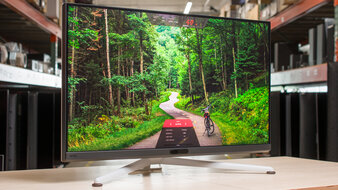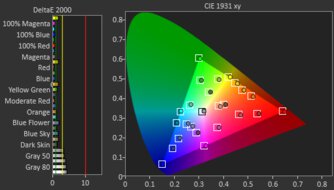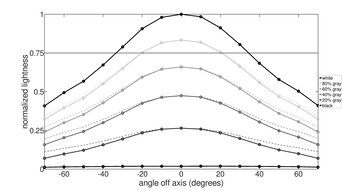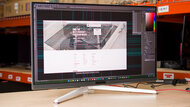
Deciding exactly where to start searching for a new monitor can be difficult. There are many different types of monitors available in various sizes, resolutions, panel types, and refresh rates, so buying a new one isn't a straightforward process, and there's no perfect solution for everyone. While most people would be happy with a basic monitor that's good enough for everyday use, there are plenty of options that offer extra perks for different uses.
We perform thousands of tests on each monitor we buy, and we design our objective, data-filled reviews to help you make a buying decision. The best PC monitors are usually focused on gaming but also provide high-end picture quality, so they're versatile enough to use for anything from gaming to simply browsing the web. You can also consider well-rounded budget monitors, but those tend to have fewer features than higher-end models. On top of that, some monitors are designed for specific uses, like those for gaming, work, or content creation, so it's important to think about how you'll use it. If you aren't sure what to look for in a monitor or if the marketing terms confuse you, check out our monitor guides.
We've bought and tested over 365 monitors, and below, you'll find our picks for the best monitors available. If you have a more specific usage in mind, check out our recommendations for the best multimedia monitors, the best HDR monitors, the best video editing monitors, and the best photo editing monitors. You can also see all our monitor recommendations. If you want more than just a monitor, look into the best home printers.
Quick Look
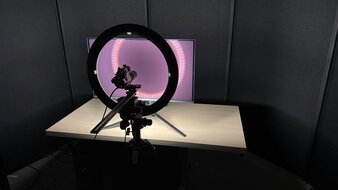




Best Monitor
 PC Gaming9.1Office8.3Editing9.3Console Gaming9.4Brightness7.2HDR Picture9.4SDR Picture10Color Accuracy9.2Response Time9.9Size27"Pixel TypeQD-OLEDMax Refresh Rate240 HzSee all our test resultsNative Resolution3840 x 2160
PC Gaming9.1Office8.3Editing9.3Console Gaming9.4Brightness7.2HDR Picture9.4SDR Picture10Color Accuracy9.2Response Time9.9Size27"Pixel TypeQD-OLEDMax Refresh Rate240 HzSee all our test resultsNative Resolution3840 x 2160The best computer monitor we've tested is the ASUS ROG Swift OLED PG27UCDM. It's a premium 27-inch, 4k monitor that has a QD-OLED panel. Although it's designed with gaming in mind, it's great for a variety of uses and offers fantastic picture quality. Your favorite content looks realistic, as it displays deep and inky blacks in dark rooms and makes highlights pop and colors look vivid. It has a few features for versatility, like its USB-C port with 90W of power delivery and a KVM switch, which helps if you want to change sources and use the same keyboard and mouse on both.
It's also one of the best options for gaming because of its 240Hz refresh rate and near-instantaneous response time. It even has HDMI and DisplayPort 2.1 bandwidth to take full advantage of gaming consoles and modern graphics cards. While OLEDs like this risk permanent burn-in with constant exposure to the same static elements over time, it isn't so much of a risk if you vary your usage. Even if you want to use it for work, its 4k resolution helps result in sharp text clarity, and the 27-inch screen is big enough to place two windows side-by-side. However, you can also check out the 32-inch ASUS ROG Swift OLED PG32UCDM if you want a larger screen. It performs similarly, but text isn't as sharp, and this monitor doesn't support DisplayPort 2.1 bandwidth.
See our recommendations for the best OLED monitors.
Best Upper Mid-Range Monitor
 PC Gaming7.9Office8.4Editing8.2Console Gaming8.5Brightness9.3HDR Picture7.6SDR Picture7.4Color Accuracy8.8Response Time8.3Size32"Pixel TypeIPSMax Refresh Rate144 HzSee all our test resultsNative Resolution3840 x 2160
PC Gaming7.9Office8.4Editing8.2Console Gaming8.5Brightness9.3HDR Picture7.6SDR Picture7.4Color Accuracy8.8Response Time8.3Size32"Pixel TypeIPSMax Refresh Rate144 HzSee all our test resultsNative Resolution3840 x 2160If you still want a premium display for a bit less or are concerned about the risk of burn-in, check out the BenQ MOBIUZ EX321UX. It's different from the ASUS ROG Swift OLED PG27UCDM because instead of having a QD-OLED panel, it uses an IPS panel with Mini LED backlighting. This means it doesn't have the same deep, inky blacks in dark rooms without any haloing, and it doesn't display the same vivid colors either. However, its 1,152 local dimming zones still help improve its contrast ratio, producing deep enough blacks in dark rooms, though it has haloing around bright objects.
However, this is a more versatile display for different uses, including work, than the ASUS. Besides the fact that it doesn't risk burn-in with constant exposure to the same static elements over time, it also gets incredibly bright. Even though some reflections on the screen can get distracting, it easily gets bright enough to fight this glare. It also has some productivity features, like a USB-C port with 65W of power and DisplayPort Alt Mode to connect a laptop, and a KVM switch that makes it easy to change sources and use the same peripherals on both.
See our recommendations for the best 4k monitors.
Best Work Monitor
 PC Gaming6.4Office8.4Editing8.0Console Gaming7.9Brightness8.0HDR Picture6.1SDR Picture7.5Color Accuracy8.6Response Time4.1Size32"Pixel TypeIPSMax Refresh Rate120 HzSee all our test resultsNative Resolution3840 x 2160
PC Gaming6.4Office8.4Editing8.0Console Gaming7.9Brightness8.0HDR Picture6.1SDR Picture7.5Color Accuracy8.6Response Time4.1Size32"Pixel TypeIPSMax Refresh Rate120 HzSee all our test resultsNative Resolution3840 x 2160While most of the gaming monitors mentioned above are good enough for work purposes, there are other great options if you want a dedicated work monitor without gaming perks. The Dell U3225QE is excellent for work as it has features for almost any type of work. Plus, the main advantage of getting it over other monitors with an OLED panel, like the ASUS ROG Swift OLED PG27UCDM, is that you can use it to work for long hours and not worry about burn-in.
Besides that, text looks sharp, and the 32-inch screen is big enough to open multiple windows side by side. It also has wide viewing angles and incredible ergonomics, so it's easy to share your screen with someone else or adjust it to a preferred position. Another advantage of getting this over other 4k options, like the BenQ MOBIUZ EX321UX, is that it has a massive USB hub to which you can connect a variety of devices. This includes five USB-A ports and five more USB-C ports, and it supports Thunderbolt 4 and 140W of power, which is ideal if you want to connect a MacBook. If you're looking for a smaller 27-inch version of this monitor, check out the less expensive Dell U2725QE, which has very similar performance and nearly identical features.
See our recommendations for the best work monitors.
Best Mid-Range Monitor
 PC Gaming7.7Office8.8Editing8.1Console Gaming8.5Brightness8.8HDR Picture7.2SDR Picture7.2Color Accuracy9.0Response Time7.9Size27"Pixel TypeIPSMax Refresh Rate160 HzSee all our test resultsNative Resolution3840 x 2160
PC Gaming7.7Office8.8Editing8.1Console Gaming8.5Brightness8.8HDR Picture7.2SDR Picture7.2Color Accuracy9.0Response Time7.9Size27"Pixel TypeIPSMax Refresh Rate160 HzSee all our test resultsNative Resolution3840 x 2160If the BenQ MOBIUZ EX321UX is still out of your price range, the Acer Nitro XV275K P3biipruzx is a solid mid-range option. It often goes on sale and is worth getting when it does. It's actually very similar to the BenQ because it also uses Mini LED backlighting, with 576 dimming zones, but there are still some trade-offs. For example, the Acer doesn't get as bright, but because it has better reflection handling, it's still a good choice to use in a well-lit room. The Acer also has fewer features, as it has a smaller USB hub and supports less bandwidth over its DisplayPort input.
It's still a fantastic monitor for both work and play. It has a 4k resolution, like the BenQ, and even though it has a smaller screen, it has higher pixel density, and text looks incredibly sharp. Besides that, it has everything you'd want in a gaming monitor, like HDMI 2.1 bandwidth to take advantage of gaming consoles. Motion looks sharp, and this monitor has low input lag with most signals, but it increases with 60Hz signals, which is disappointing if you play games that need fast reactions.
See our recommendations for the best Mini LED monitors.
Best Budget Monitor
 PC Gaming8.2Office7.6Editing7.9Console Gaming7.4Brightness8.3HDR Picture8.0SDR Picture8.2Color Accuracy8.8Response Time8.5Size27"Pixel TypeVAMax Refresh Rate180 HzSee all our test resultsNative Resolution2560 x 1440
PC Gaming8.2Office7.6Editing7.9Console Gaming7.4Brightness8.3HDR Picture8.0SDR Picture8.2Color Accuracy8.8Response Time8.5Size27"Pixel TypeVAMax Refresh Rate180 HzSee all our test resultsNative Resolution2560 x 1440If you don't need a dedicated work monitor and are looking for a multi-use monitor like the Acer Nitro XV275K P3biipruzx on a budget, look at the AOC Q27G3XMN. It has a lower 1440p resolution than the Acer, so text and images aren't as sharp and detailed. Another trade-off for getting something cheaper is that the AOC has fewer features than the Acer, as it doesn't have a USB hub to connect your devices. That's normal for an entry-level monitor, so you must ensure your computer has enough ports to connect your devices.
The biggest advantage of the AOC, especially against other low-cost monitors, is that it uses Mini LED backlighting, similar to that of the Acer. This means it displays deep blacks against bright highlights, which is great for watching HDR content, especially in dark rooms. It even gets bright enough to fight glare in a well-lit room. Lastly, it has gaming features like a 180Hz refresh rate, and it has a fast response time, but there's smearing behind fast-moving objects. You can also check out the AOC Q27G40XMN, which gets brighter and has a better local dimming system. However, it has worse motion handling and ergonomics.
See our recommendations for the best budget and cheap monitors.
Best Cheap Monitor
 PC Gaming6.9Office7.7Editing6.8Console Gaming6.1Brightness7.1HDR Picture4.9SDR Picture5.8Color Accuracy8.1Response Time7.4Size27"Pixel TypeIPSMax Refresh Rate170 HzSee all our test resultsNative Resolution2560 x 1440
PC Gaming6.9Office7.7Editing6.8Console Gaming6.1Brightness7.1HDR Picture4.9SDR Picture5.8Color Accuracy8.1Response Time7.4Size27"Pixel TypeIPSMax Refresh Rate170 HzSee all our test resultsNative Resolution2560 x 1440If you want something less expensive than the AOC Q27G3XMN, look at the MSI G274QPF-QD. It performs similarly to the AOC in several ways, such as its 1440p resolution and fantastic ergonomics. It also has very good SDR brightness, so you can use it in a typical room. It even has some things the AOC lacks. You can connect it to your computer via USB-C, and it lacks the AOC's smearing with fast-moving objects, though it does have more blur overall.
The main difference between these two monitors is their HDR performance. The MSI doesn't get bright enough for highlights to pop, and because it lacks a local dimming system and has sub-par contrast, deep blacks appear gray in a dark room. Its colors aren't as vivid as those on the AOC, though it still displays a wide range of colors. Provided you don't plan on using it for HDR, the MSI is a versatile monitor that works well for gaming or productivity.
See our recommendations for the best budget and cheap monitors.
Notable Mentions
- Dell Alienware AW2725Q:
The Dell Alienware AW2725Q is a premium 4k, 240Hz QD-OLED that's cheaper than the ASUS ROG Swift OLED PG27UCDM. It's worth getting if you find the ASUS too expensive, but it also has fewer features and doesn't get as bright.
See our review - ASUS ROG Strix OLED XG27ACDNG:
The ASUS ROG Strix OLED XG27ACDNG is an upper mid-range monitor that's a gaming alternative to the BenQ MOBIUZ EX321UX. It has a higher 360Hz refresh rate, and its QD-OLED display has better motion handling. However, it has a lower resolution than the BenQ and risks burn-in, so it isn't as versatile.
See our review - ASUS ROG Strix OLED XG27AQDMG:
The ASUS ROG Strix OLED XG27AQDMG is an OLED monitor in the same price range as the Acer Nitro XV275K P3biipruzx. Consider the ASUS if you want the best picture quality for the price. It's better for gaming, too, but it has a lower resolution than the Acer and doesn't get as bright.
See our review - Dell U4025QW:
The Dell U4025QW is a work monitor that's a much larger alternative to the Dell U3225QE, as it has a 40-inch ultrawide screen. It's a good choice if you need such a big display for multitasking, and it also has a large USB hub, but it costs a lot more.
See our review
Recent Updates
Aug 15, 2025:
We replaced the Dell U2725QE with the Dell U3225QE, as it has a larger screen. We also replaced the Dell P2425H with the MSI G274QPF-QD, as it gets brighter, has a higher resolution, and has HDR support. Finally, we removed the Samsung Odyssey G55C S27CG55 from the Notable Mentions.
Jul 08, 2025:
We replaced the MSI MPG 321URX QD-OLED with the ASUS ROG Swift OLED PG27UCDM because the ASUS is better and easier to find. We also replaced the MSI MPG 271QRX QD-OLED with the BenQ MOBIUZ EX321UX, which is more versatile. We replaced the ASUS ProArt Display PA279CRV with the Dell U2725QE for consistency with other recommendations, and we added the Dell P2425H as the 'Best Cheap Monitor.' We made changes in the Notable Mentions to reflect these changes, by removing the Dell Alienware AW3225QF, ASUS ROG Swift OLED PG32UCDM, Gigabyte AORUS FO27Q3, and the P2425H, and adding the Dell Alienware AW2725Q, ASUS ROG Strix OLED XG27ACDNG, and the Samsung Odyssey G55C S27CG55.
Apr 07, 2025:
We removed the LG 27GP850-B/27GP83B-B because it's hard to find now. We also replaced the ASUS ROG Strix XG27ACS with the ASUS ROG Strix OLED XG27AQDMG in the Notable Mentions.
Feb 19, 2025:
We replaced the Samsung Odyssey OLED G8/G80SD S32DG80 with the MSI MPG 321URX QD-OLED for consistency with other articles, as the MSI is cheaper. We also replaced the Dell G2724D with the LG 27GP850-B/27GP83B-B because the Dell is hard to find. We removed the Dell U2723QE and renamed the ASUS ProArt Display PA279CRV as 'Best Work Monitor' to be consistent with other articles. Lastly, in the Notable Mentions, we removed the LG 32GS95UE-B and Dell Alienware AW2725DF and added the Gigabyte AORUS FO27Q3 and the ASUS ROG Strix XG27ACS to represent the current market better. We also introduced a new format to the article.
Dec 18, 2024:
Replaced the Gigabyte AORUS FO27Q3 with the MSI MPG 271QRX QD-OLED, as the MSI has 90W of power delivery and otherwise similar features and performance, and costs less.
All Reviews
Our recommendations are based on what we think are the best computer monitors currently available. They're adapted to be valid for most people in each price range. Our rating is based on our review, factoring in price and feedback from our visitors.
If you'd prefer to make your own decision, here's the list of all of our monitor reviews. Be careful not to get too caught up in the details. Most of the best PC monitors are good enough to please most people, and the things we fault monitors on are often not noticeable unless you really look for them.
Comments
Best Monitors: Main Discussion
What do you think of our picks? Let us know below.
Looking for a personalized buying recommendation from the RTINGS.com experts? Insiders have direct access to buying advice on our insider forum.
Update: Replaced the Samsung HW-Q990B with the next generation Samsung HW-Q990C.
What do you think of these changes? Let us know



